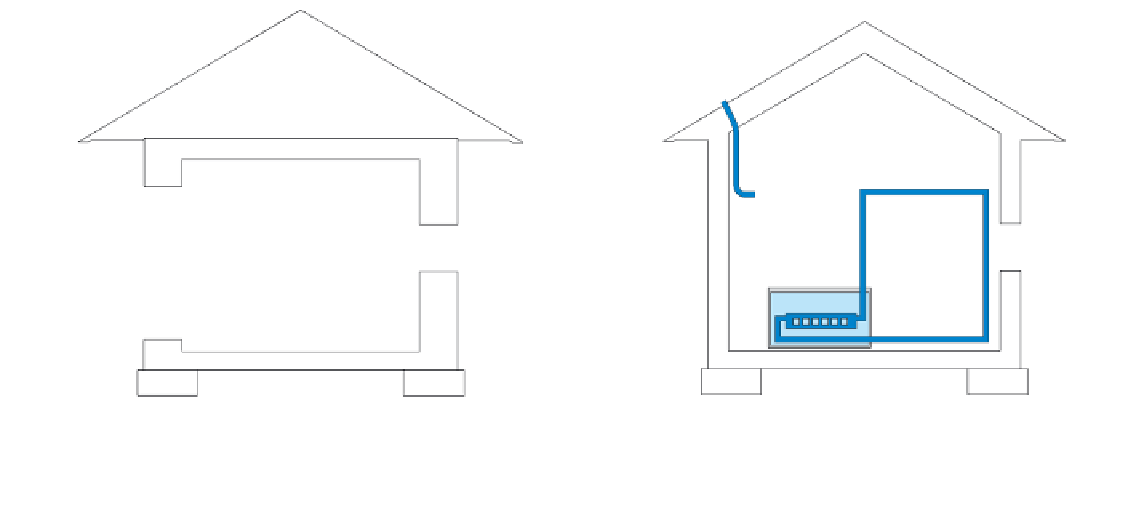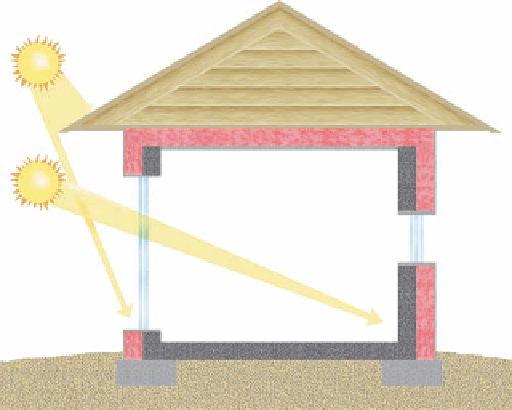Environmental Engineering Reference
In-Depth Information
Science: Passive and Active Solar
Energy Heating
We can heat buildings by orienting them toward the
sun (passive solar heating) or by pumping a liquid
such as water through rooftop collectors (active solar
heating).
Buildings and water can be heated by solar energy us-
ing two methods: passive and active (Figure 13-29). A
passive solar heating system
absorbs and stores heat
from the sun directly within a structure (Figure 13-29,
left, and Figure 13-30, p. 314). Energy-efficient win-
dows and attached greenhouses face the sun to collect
solar energy by direct gain. Walls and floors of con-
crete, adobe, brick, stone, salt-treated timber, and wa-
ter in metal or plastic containers store much of the col-
lected solar energy as heat and release it slowly
throughout the day and night. A small backup heating
system such as a vented natural gas or propane heater
may be used but is not necessary in many climates.
(See the Guest Essay by Nancy Wicks on this topic on
the website for this chapter.)
On a life-cycle cost basis, good passive solar and
superinsulated design is the cheapest way to heat a
home or small building in regions with access to am-
ple sunlight. Such a system usually adds 5-10% to the
construction cost, but the life-cycle cost of operating
such a house is 30-40% lower. The typical payback
time for passive solar features is 3-7 years.
An
active solar heating system
absorbs energy
from the sun by pumping a heat-absorbing fluid (such
as water or an antifreeze solution) through special col-
lectors usually mounted on a roof or on special racks to
face the sun (Figure 13-29, right). Some of the collected
heat can be used directly. The rest can be stored in a
large insulated container filled with gravel, water, clay,
or a heat-absorbing chemical for release as needed. Ac-
tive solar collectors can also supply hot water and are
widely used in areas of the world with sunny climates.
Figure 13-31 (p. 314) lists the major advantages
and disadvantages of using passive or active solar
heating systems for heating buildings. Passive solar
energy is great for new homes in areas with adequate
sunlight. But it cannot be used to heat existing homes
and buildings not oriented to receive sunlight or
where other buildings or trees block access to sunlight.
Active solar collectors are good for heating water in
sunny areas. Most analysts do not expect widespread
use of active solar collectors for heating houses be-
cause of their high costs, maintenance requirements,
and unappealing appearance.
Science: Cooling Houses Naturally
We can cool houses by superinsulating them, taking
advantage of breezes, shading them, having light-
colored or garden roofs, and using geothermal cooling.
Here are some ways to have a cooler house. Use su-
perinsulation and superinsulating windows, open
windows to take advantage of breezes, and use fans to
keep air moving. Block the high summer sun with de-
ciduous trees and window overhangs (Figure 13-30,
top), or with awnings.
Use a light-colored roof to reflect as much as 80%
of the sun's heat, compared to only 8% for a dark-gray
roof. Alternatively, use insulating garden-top roofs
(Figure 13-30, bottom). Suspend reflective insulating
foil in an attic to block heat from radiating down into
the house.
Summer
sun
Heat to house
(radiators or
forced air duct)
Pump
Heavy
insulation
Hot
water
tank
Superwindow
Winter
sun
Superwindow
Super-
window
Heat
exchanger
Stone floor and wall
for heat storage
PASSIVE
ACTIVE
Figure 13-29
Solutions:
passive and active solar heating for a home.
































